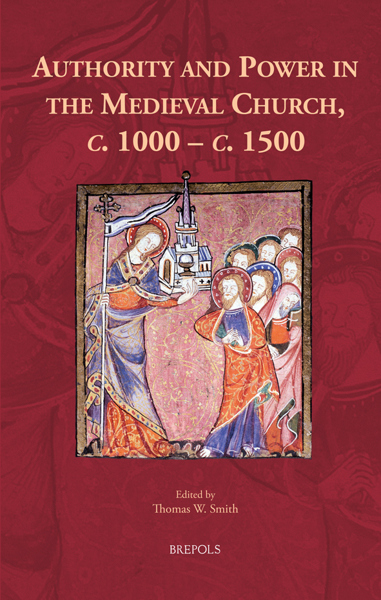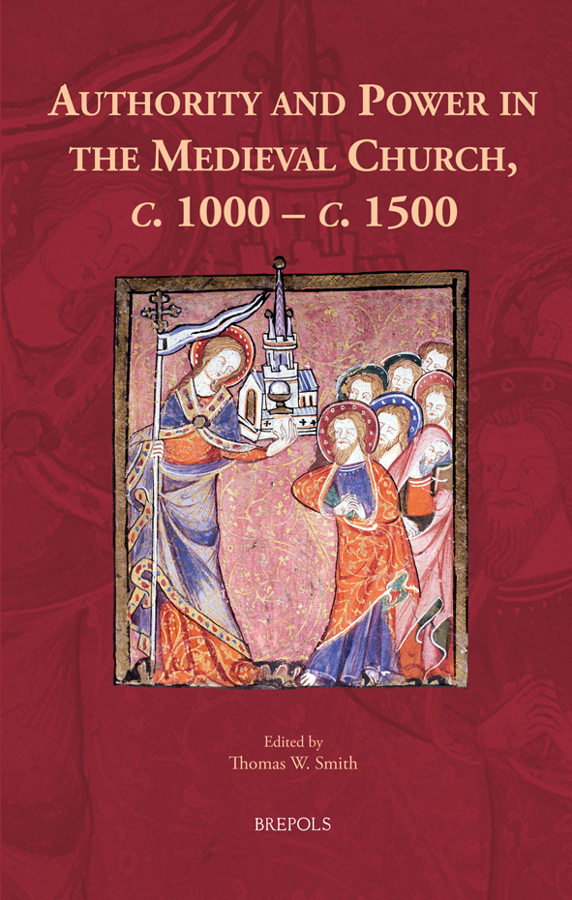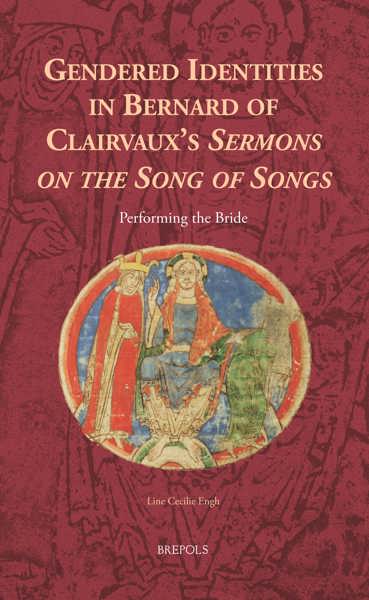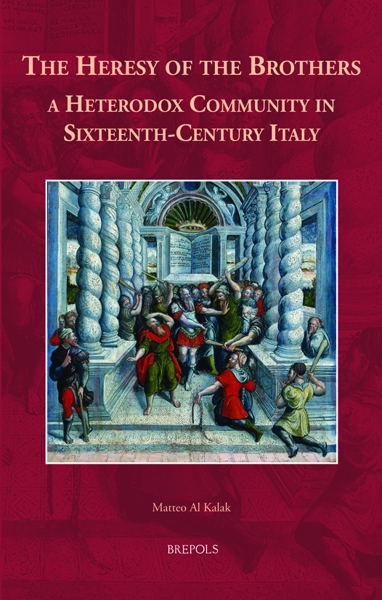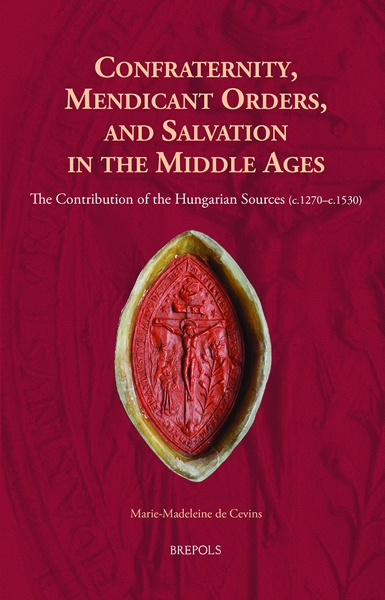
Authority and Power in the Medieval Church, c. 1000–c. 1500
Thomas W. Smith (ed)
- Pages: 412 p.
- Size:156 x 234 mm
- Illustrations:19 b/w, 2 tables b/w.
- Language(s):English
- Publication Year:2020
- € 105,00 EXCL. VAT RETAIL PRICE
- ISBN: 978-2-503-58529-1
- Hardback
- Available
- € 105,00 EXCL. VAT RETAIL PRICE
- ISBN: 978-2-503-58530-7
- E-book
- Available
Interdisciplinary studies in the conceptualization and exercise of authority and power in the medieval Church.
"Die Aufsatzsammlung bietet dem Leser ein Panoptikum anregender Aufsätze, die angesichts der Breite der Ansätze und behandelten Themen vermutlich von wenigen Lesern zur Gänze goutiert werden." (Andreas Kistner, in Sehepunkte, 01/2021)
“(…) it does succeed in stimulating thought, particularly about the institutional Church's claims to authority and the ways it attempted to marshal sufficient power to implement them. It should help inspire many subsequent studies.” (John Howe, in The Medieval Review, 21.08.35)
“This is a superb and substantial collection. Thomas Smith has successfully marshalled twenty-two chapters in this interdisciplinary exploration of power and authority in the medieval Church, curating a varied yet coherent compilation (…) This review is a necessarily brief account of a rich collection that makes a useful contribution to the field of ecclesiastical history and is of considerable value to scholars and students of the medieval Latin Church.” (Beth C. Spacey, in Parergon, 38/2, 2021, p. 262)
"Books that manage to encapsulate something essential but often elusive quickly turn indispensable for scholars. Authority and Power in the Medieval Church is one such volume. Expertly edited by Thomas W. Smith, the collection of essays tackles one of the most profound issues of studying the Medieval Church—the interplay between authority and power as understood, articulated, and exercised by ecclesiastic actors and received by their surroundings." (Agata Zielinska, in Reviews in History (review no. 2467), DOI: 10.14296/RiH/2014/2467, 24 October, 2022)
Thomas W. Smith, PhD (Royal Holloway, University of London, 2013), teaches history at Rugby School and is a Fellow of the Royal Historical Society. He is the author of Curia and Crusade: Pope Honorius III and the Recovery of the Holy Land, 1216–1227 (Brepols, 2017), which was Highly Commended in the British Records Association’s Janette Harley Prize 2018.
While they often go hand-in-hand and the distinction between the two is frequently blurred, authority and power are distinct concepts and abilities – this was a problem that the Church tussled with throughout the High and Late Middle Ages. Claims of authority, efforts to have that authority recognized, and the struggle to transform it into more tangible forms of power were defining factors of the medieval Church’s existence.
As the studies assembled here demonstrate, claims to authority by members of the Church were often in inverse proportion to their actual power – a problematic paradox which resulted from the uneven and uncertain acceptance of ecclesiastical authority by lay powers and, indeed, fellow members of the ecclesia. The chapters of this book reveal how clerical claims to authority and power were frequently debated, refined, opposed, and resisted in their expression and implementation. The clergy had to negotiate a complex landscape of overlapping and competing claims in pursuit of their rights. They waged these struggles in arenas that ranged from papal, royal, and imperial curiae, through monastic houses, law courts and parliaments, urban religious communities and devotional networks, to contact and conflict with the laity on the ground; the weapons deployed included art, manuscripts, dress, letters, petitions, treatises, legal claims, legates, and the physical arms of allied lay powers.
In an effort to further our understanding of this central aspect of ecclesiastical history, this interdisciplinary volume, which effects a broad temporal, geographical, and thematic sweep, points the way to new avenues of research and new approaches to a traditional topic. It fuses historical methodologies with art history, gender studies, musicology, and material culture, and presents fresh insights into one of the most significant institutions of the medieval world.
Acknowledgements, Abbreviations, List of Illustrations
Introduction — THOMAS W. SMITH
Part I: Concepts of Papal Authority
- Privilegium Romanae Ecclesiae: The Language of Papal Authority over the Church in the Eleventh Century — I. S. ROBINSON
- Papal Authority and Power during the Minority of Emperor Frederick II — BENEDICT WIEDEMANN
- The Medieval Papacy and the Concepts of ‘Anti-Judaism’ and ‘Anti-Semitism’ — REBECCA RIST
- The Place of the Papacy in Four Illuminated Histories from Thirteenth-Century England — LAURA CLEAVER
- The Interface between Papal Authority and Heresy: The Legates of Honorius III in Languedoc, 1216–1227 — THOMAS W. SMITH
- Papal Legates in Thirteenth-Century Hungary: Authority, Power, Reality — GÁBOR BARABÁS
- Pope Alexander IV, King Henry III and the Imperial Succession: Master Rostand’s Role in the Sicilian Business, 1255–1258 — PHILIPPA J. MESIANO
- Cardinal Gerard of Parma as Co-Ruler in the Kingdom of Sicily, 1285–1289 — JEAN DUNBABIN
- The Power of Tradition: The Papacy and the Churches of the East, c. 1100–1300 — † BERNARD HAMILTON
- Politics and Power in Latin Efforts at Church Union, 1300–1360 — JAMES HILL
- Modifications to Papal Trade Licences at the Avignon Curia — MIKE CARR
- The Late Medieval Papal Chapel: A Culture of Power and Authority — MATTHEW ROSS
- Dress to Impress: Jacque de Vitry’s Clothing and Episcopal Self-Fashioning — JAN VANDEBURIE
- Imaging Power: Gender, Power, and Authority in Florentine Piety — CATHERINE LAWLESS
- Royal Women, the Franciscan Order, and Ecclesiastical Authority in Late Medieval Bohemia and the Polish Duchies — KIRSTY DAY
- Shall the First Be Last? Order and Disorder Amongst Henry II’s Bishops — NICHOLAS VINCENT
- Eustathios’s Life of a Married Priest and the Struggle for Authority in Twelfth-Century Byzantium — MAROULA PERISANIDI
- The Bishop, the Convent and the Community: The Attempt to Enclose the Nuns of S. Giustina, Lucca, 1301–1302 — CHRISTINE MEEK
- Archbishop Walter Reynolds, the Clerical gravamina, and Parliamentary Petitions from the Clergy in the Early Fourteenth Century — MATTHEW PHILLIPS
- The Power of the Cardinals: Decision-Making at the Papal Curia in Avignon — MELANIE BRUNNER
- Negotiation and Conflict: The Templars’ and Hospitallers’ Relations with Diocesan Bishops in Britain and Ireland — HELEN J. NICHOLSON
- Hospitaller and Teutonic Order Lordships in Germany — KARL BORCHARDT
